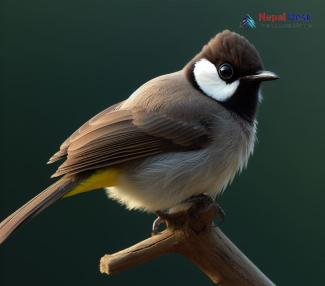The avian world is at once varied and vibrant, boasting thousands of species worldwide. Among these captivating creatures stands the White-eared Bulbul (Pycnonotus leucotis), drawing the interest of birdwatchers and nature enthusiasts alike. In this article, we'll dive into the fascinating details of this bird's taxonomy, appearance, habitat, diet, breeding practices, captivating trivia, and its existence in Nepal.
Taxonomy and Appearance
As members of the Pycnonotidae family, White-eared Bulbuls are medium-sized birds reaching roughly 20 centimeters in length. Easily recognizable by their sleek black heads adorned with distinctive white patches extending behind the eyes to nearly the back of their necks. Their dark brown upper parts contrast with white underparts, while tails flaunt white tips adding to their distinguished look. The bird's strikingly orange bill further highlights its unique features.
Habitat and Food Preferences
White-eared Bulbuls frequent several South Asian regions, particularly India, Pakistan, Iran, and Nepal. They prefer dry environments with minimal vegetation like scrublands or gardens rich with fruit-bearing trees.
These birds predominantly sustain themselves on fruit, seeds, nectar from blossoming flowers, and insects. Their adaptability enables them to thrive not only in natural habitats but also in urban areas where food is readily available.
Mating and Nesting
White-eared Bulbul breed between March and July each year. As monogamous creatures that mate for life, they're known for intricately constructed cup-shaped nests that are built by both partners utilizing twigs, leaves, and grass—typically situated within tree forks or thorny bushes.
Females usually lay 2 to 3 eggs with an incubation period lasting about 12 days. Both parents play a role in rearing offspring, offering nourishment and protection until the young birds fledge between 12 to 15 days later.
Interesting Tidbit:
Despite primarily being fruit-eaters, White-eared Bulbuls exhibit a fondness for highly fragrant flowers. Observations show them sipping nectar from the likes of jasmine and eucalyptus, illustrating a fascinating balance between their affinity for fruity sustenance and sugary floral nectar.
Nepalese Presence
In Nepal, White-eared Bulbuls inhabit plains or Terai regions at lower elevations. They congregate in small-to-medium-sized groups in agricultural lands, urban environments, semi-arid terrains sporting thorny scrub, and occasionally wooded areas. The bird's adaptable nature ensures it remains a common sight throughout Nepal, serenading visiting birdwatchers with distinct melodies during nature excursions.
Ultimately, the White-eared Bulbul proves an exceptional standout among South Asian bird species. Its remarkable appearance, unrivaled adaptability across environments, and intriguing feeding habits captivate not only avid bird lovers but also those just beginning to explore ornithology.




